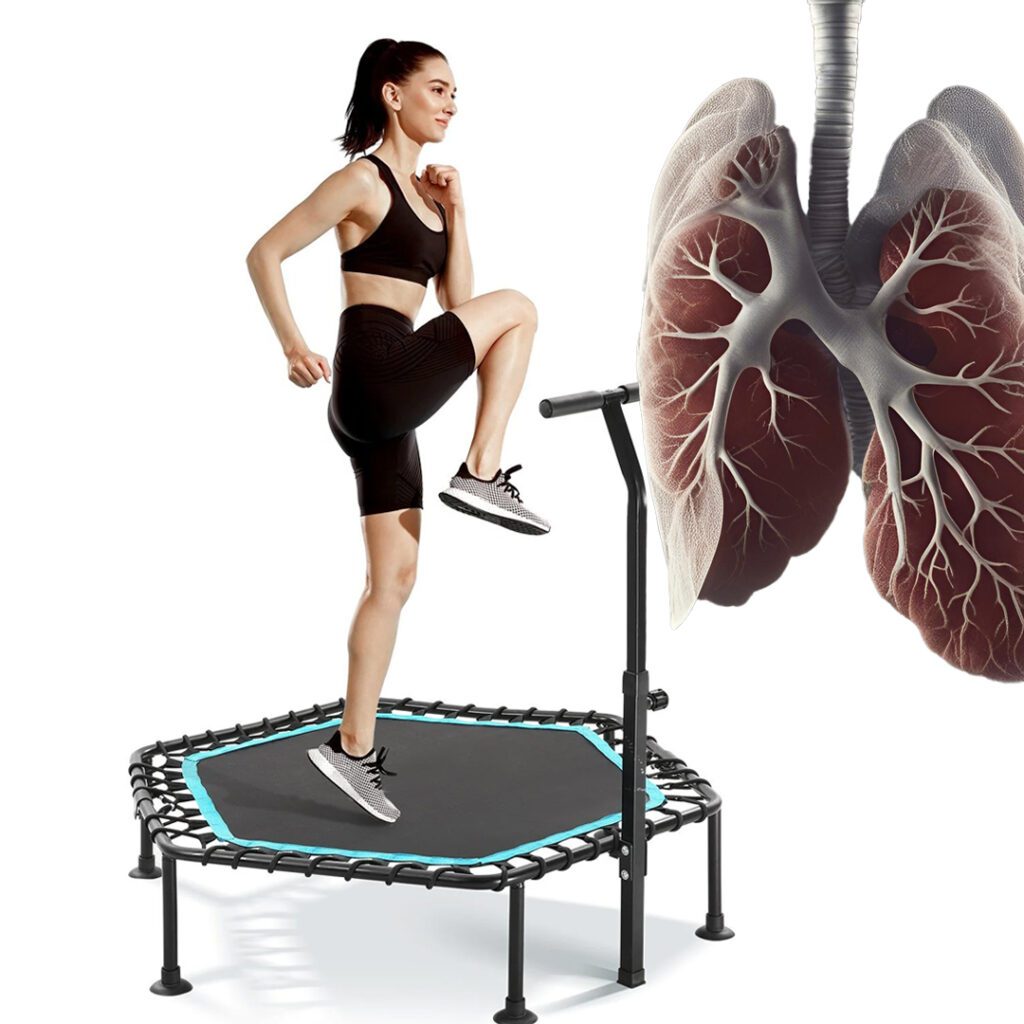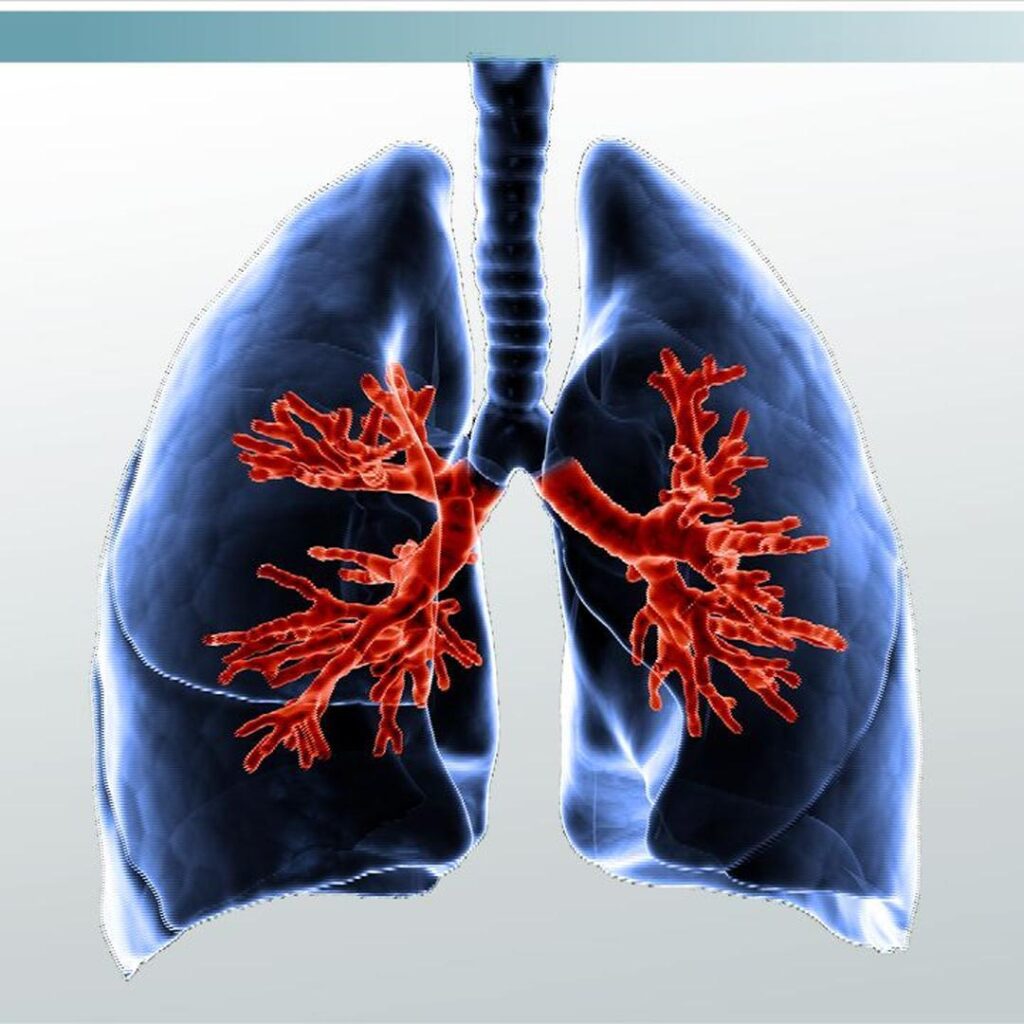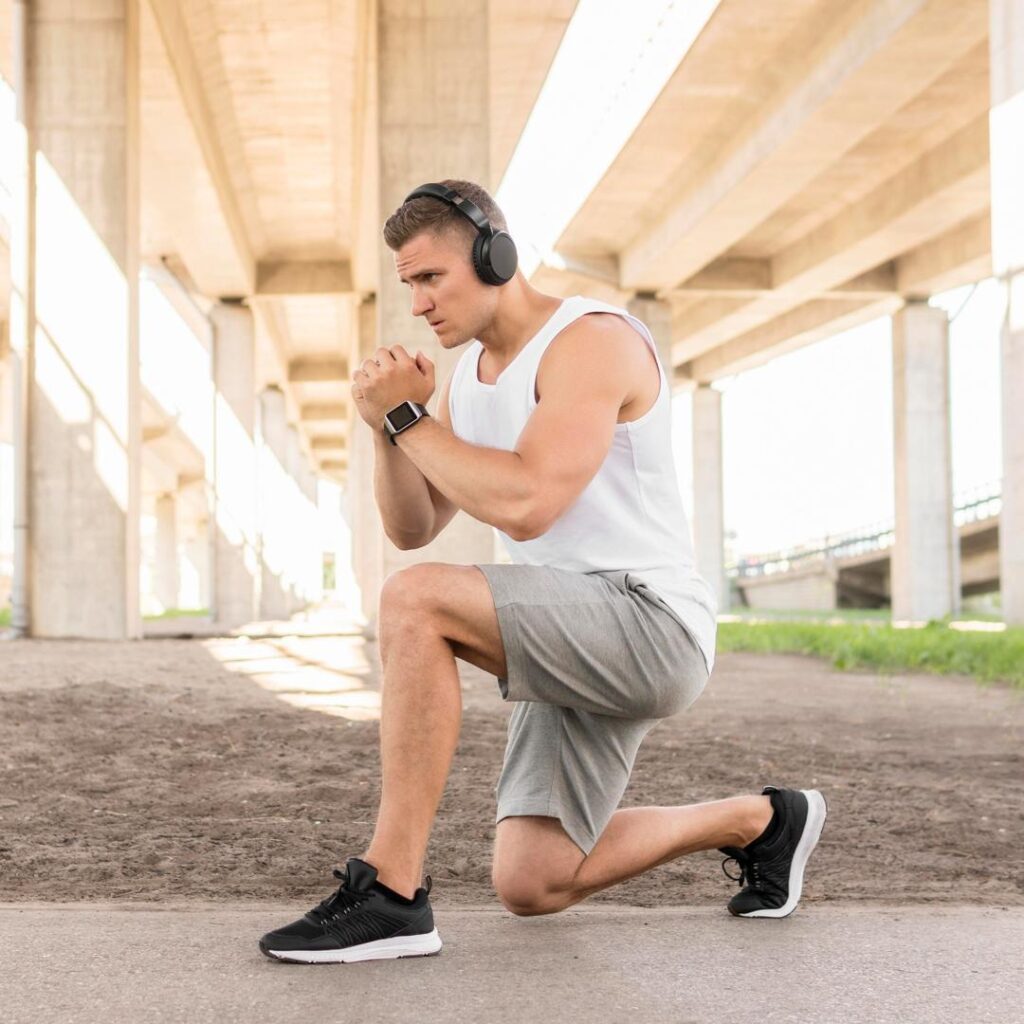
Trampolines exercises are gaining popularity in the fitness world not only because of the fun they offer but also due to the range of health benefits they provide. Referred to as rebounding in fitness communities, trampolining offers a perfect combination of enjoyment and health advantages that attract both children and adults. While it is commonly recognized that trampoline exercise helps enhance muscle tone and improve cardiovascular health, it is also gaining attention for its potential positive effects on lung health.
In this article, we know how jumping on a trampoline might benefit the lungs. Could this enjoyable activity help improve lung capacity and efficiency? Let’s explore the science behind trampolining and uncover whether it’s as good for our lungs as it is for our spirits.
Understanding the Lungs
Before we know how trampolining can influence lung health, let’s first understand the basics of lung function and why keeping them healthy is so crucial.
How Lungs Work
- Inhalation and Exhalation: Breathing in brings oxygen into the lungs, where it is absorbed into the bloodstream. Breathing out removes carbon dioxide from the body.
- Gas Exchange: This critical exchange happens in the alveoli, tiny sacs within the lungs where oxygen is transferred to the blood, and carbon dioxide is removed.
- Supporting Muscles: The diaphragm and intercostal muscles help expand and contract the lungs, aiding this process.

Importance of Lung Health
There are many advantages to putting lung health first for our general wellbeing. In addition to supporting the best possible oxygenation of tissues, healthy lungs boost immunity, increase physical stamina, and lower the risk of infection. Here’s why lung health is vital:
- Energy Levels: Efficient lungs supply ample oxygen to all parts of the body, boosting energy and stamina.
- Disease Prevention: Healthy lungs are better at warding off respiratory illnesses and coping with environmental pollutants.
- Overall Wellbeing: Good lung capacity supports all physical activities and improves quality of life.
Exercise and Lung Health
Regular physical activity like trampoline jumping is one of the best things you can do for your lungs. Here’s how exercise benefits these essential organs:
- Increased Lung Capacity: Exercise helps improve the efficiency and capacity of your lungs, which means they can hold more air and extract oxygen more effectively.
- Strengthened Respiratory Muscles: Just like other muscles, the muscles around the lungs become stronger with regular exercise, making breathing both easier and more efficient.
- Improved Clearance: Physical activity helps clear out the airways, reducing mucus and other materials that can cause congestion and infections. Sports trampolines are best to perform physical activities.
Trampoline Exercises Explained
In- ground Trampoline exercise, often referred to as rebounding, is an invigorating form of physical activity that involves bouncing on a trampoline. Let’s break down what rebounding involves and explore the variety of exercises that can be performed on a trampoline.
What is Rebounding?
Rebounding makes use of a trampoline’s elastic surface to perform movements that range from simple, gentle bounces to more vigorous, high-intensity jumps and other aerobic maneuvers. This elasticity provides a unique resistance that is not found in other types of exercise, adding an extra dimension to the workout.

Types of Trampoline Exercises
- Basic Bouncing: Ideal for beginners or those looking for a low-intensity workout, basic bouncing involves gentle jumps where the feet barely leave the mat. This type of exercise helps to increase blood flow, warm up muscles, and gently work the respiratory system.
- Aerobic Bouncing: Stepping up the intensity, aerobic bouncing includes higher jumps and incorporates various arm movements. This can significantly raise the heart rate, providing a cardiovascular workout that benefits the lungs and heart.
- Strength Training Moves: By incorporating squats, lunges, or abdominal crunches while on a trampoline, you engage more muscle groups. The unstable surface of the trampoline increases the challenge and effectiveness of these traditional exercises.
- Balance and Agility Drills: Exercises like jumping from side to side or front to back help improve balance and coordination. These movements also enhance spatial awareness and reflexes.
- High-Intensity Interval Training (HIIT): For those who want a challenge, incorporating intervals of intense jumping followed by periods of rest or lower intensity can make for a highly effective HIIT session. This method is excellent for boosting metabolic rate and improving lung capacity.
- Dance and Choreography: Some enjoy choreographing routines to music, which can turn a trampoline workout into a dance party. This not only makes the exercise session enjoyable but also increases its duration and intensity unconsciously.
Benefits of Trampolining for Lung Health
Trampolining isn’t just a fun way to exercise; it also offers significant benefits for lung health. Here’s how trampolining can boost lung health and what the research says about it.
Enhancing Lung Capacity and Efficiency
- Improved Ventilation: Trampolining requires controlled, deeper breathing due to the physical exertion and rhythmic nature of the exercise. This increased demand helps expand the lung capacity, allowing for more air volume per breath, which can be particularly beneficial for athletes or those with respiratory issues.
- Increased Oxygen Uptake: The cardiovascular workout provided by trampolining increases the oxygen demand, stimulating the lungs to maximize oxygen uptake from the blood. Over time, this can lead to more efficient lung function as the body adapts to the increased oxygen requirements.
- Strengthens Respiratory Muscles: Regular trampoline workouts help strengthen the muscles involved in breathing, such as the diaphragm and intercostal muscles. Stronger muscles can aid in the overall efficiency of the respiratory system, making breathing easier and more effective.

Promotion of Better Breathing and Increased Oxygenation
- Efficient Gas Exchange: As trampolining increases lung capacity and strengthens respiratory muscles, the efficiency of the gas exchange process in the alveoli also improves. This means better utilization of oxygen and more complete expulsion of carbon dioxide.
- Enhanced Blood Circulation: The motion of bouncing helps to increase circulation, ensuring that more oxygen-rich blood reaches vital organs. Enhanced circulation not only supports lung function but also contributes to overall health and vitality.
- Lymphatic Support: The up-and-down movement is particularly effective in stimulating the lymphatic system, which plays a crucial role in immune function and waste removal. Improved lymphatic flow can reduce the risk of respiratory infections and promote healthier lung tissue.
Comparative Analysis: Trampolining vs. Other Cardio Exercises for Lung Health
When evaluating the benefits of different cardio exercises on lung health, it’s important to consider how each activity impacts respiratory function and efficiency. Let’s get into a comparative analysis of these activities.
Overview of Exercise Types
- Trampolining (Rebounding): Utilizes a soft, elastic surface where exercises range from light bouncing to intense aerobic maneuvers.
- Running: A high-impact activity that typically requires a significant amount of lung capacity and endurance.
- Cycling: A lower-impact endurance activity that can be performed at various intensities and is often considered easier on the joints compared to running.
Impact on Lung Health
1. Lung Capacity and Efficiency
- Trampolining: Enhances lung capacity through deep, rhythmic breathing required by the bouncing motion. The g-force experienced during rebounding helps improve respiratory muscle strength.
- Running: Increases lung capacity by requiring the body to adapt to high oxygen demand, thus enhancing the overall efficiency of the lungs.
- Cycling: Primarily boosts stamina and endurance rather than significantly increasing lung capacity. It does promote better lung health through sustained aerobic exertion.
2. Breathing Technique
- Trampolining: Promotes controlled breathing, synchronizing with each bounce, which can help in training the lungs to increase oxygen intake efficiently.
- Running: Often requires rapid, shallow breathing, but can be adjusted to deeper breathing techniques to improve oxygen uptake.
- Cycling: Allows for more controlled breathing compared to running, aiding in maintaining steady oxygen levels.

3. Safety and Accessibility
- Trampolining: Low-impact nature reduces the risk of joint and muscle injuries. Suitable for all ages and skill levels.
Product recommendation: 14ft Gallus In-ground Commercial Trampoline, 11×8 ft Primus Flat Rectangular Trampoline – Grey Pads
- Running: High-impact; can increase the risk of injuries. Requires good technique and sometimes specific environments (e.g., tracks, safe roads).
- Cycling: Low-impact and generally safe but requires equipment and sometimes specific locations such as roads or bike paths.
Additional Health Benefits of Trampolining
Trampolining is more than just an exhilarating activity; it is a powerhouse of health benefits that extends well beyond lung health. Let’s know the additional benefits.
Cardiovascular Fitness
Trampolining is exceptional for strengthening the heart. Regular bouncing sessions increase heart rate, mirroring the cardiovascular benefits of traditional exercises like running or cycling but in a more joyful and low-impact manner. This continual cardiovascular workout helps:
- Strengthen the heart muscle
- Improve circulation
- Reduce the risk of cardiovascular diseases
Lymphatic Health
One of the lesser-known yet significant benefits of trampolining is its ability to enhance lymphatic drainage. The up-and-down bouncing motion effectively stimulates lymph circulation, thanks to the gravitational shifts that encourage lymph fluid to flow more efficiently. This stimulation helps:
- Remove toxins and waste from the body
- Boost immune system function
- Promote cellular health and longevity
Muscle Toning and Joint Health
Unlike many forms of high-impact exercise, trampolining is gentle on the joints while still providing ample opportunity to tone and strengthen muscles across the body. It engages multiple muscle groups, including those in the legs, core, and upper body, through varied and fun movements. Trampolining also:
- Offers a low-impact way to strengthen and tone muscles
- Improves balance and coordination by constantly challenging the core
- Enhances flexibility and reduces the risk of joint and muscle injuries

Psychological Benefits
The benefits of trampolining aren’t just physical; they’re also psychological. Engaging in this joyful activity can significantly boost your mood and mental health by:
- Reducing stress levels through fun and laughter
- Increasing endorphin production, which naturally enhances mood
- Providing a source of enjoyment and play, which is often lacking in adult exercise routines
Exercising on the family trampoline has profound benefits which help to strengthen the bone density also. Learn more..
Conclusion
To wrap it up, trampolining is not just an enjoyable activity but a comprehensive exercise with a myriad of health benefits. It significantly enhances lung capacity, boosts cardiovascular health, promotes efficient lymphatic drainage, and helps in muscle toning, all while being gentle on the joints.
If you’re looking for a fun way to improve your overall health and elevate your fitness routine, consider giving trampolining a try. Jump into this dynamic workout and experience the benefits for yourself—your body and your lungs will thank you for the breath of fresh air!





